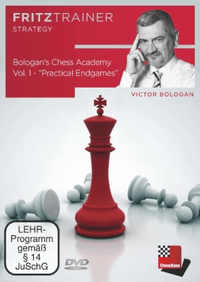Transform your chess game with “Dynamic Play” , a course meticulously designed to enhance your understanding and execution of dynamic strategies. Crafted by grandmaster Victor Bologan, this course reveals the secrets behind aggressive play and the creation of sharp, unpredictable positions on the board.
Free Video Sample: Introduction
Free Video Sample: Control over Squares, Space, Diagonals and Files
Innhold
Introduction
Tactical Weaknesses and Critical Formations
What is a tactical weakness?
What is a critical formation?
Fedoseev vs Bologan
Opposition of pieces in the same file
Control
Control over Squares, Space, Diagonals and Files
Bologan vs Palo
Bologan vs Korchnoi
Bologan vs Sai Agni Jeevetesh
Carlsen vs Anand
Freeing Sacrifice
Introduction and Bologan vs Orlov
Freeing Sacrifice in the Defence: Benjamin vs Bologan
Sacrifice for Space: Bologan vs Romanishin
Freeing Sacrifice in the Sicilian: Bologan vs Ye Jiangchuan
Freeing Sacrifice for the Bad Bishop: Giri vs Gukesh
Freeing Sacrifice for the Bad Bishop: Jakovenko vs Bologan
Sacrifice in the attack
Introduction
Destroying the position of the King: Bologan vs Danielian
Destroying the position of the King: Bologan vs Redon
Sacrifice in a closed position: Bauer vs Bologan
Another Sacrifice in the Sicilian: Bologan va Caruana
Intermediate Moves
Introduction and Example 1
Example 2
Example 3
Intermediate Moves in the Endgame: Kramanik vs Karjakin
Example 5
A more complex example: Movsesian vs Caruana
Pawn Attack
Introduction
Subtle preparing moves: Bologan vs Anand
Attack in the centre: Potkin vs Bologan
Breakthrough: Bologan vs Najer
Breakthrough: Bologan vs Mchedlishvili
Looking for the Weaknesses: Bologan vs Wang Hao
Nf4 Sacrifice in the King's Indian
Introduction and Kamsky vs Kasparov
Petrosian vs Geller
Kotov vs Gligoric
Chernin vs Polgar
Practice Positions
Control: Bologan vs Tischbierek
Freeing Sacrifice: Morozevich vs Bologan
Intermediate Moves: Mamedov vs Organdziev
Nf4 Sacrifice: Sulashvili vs Miroshnichenko
Pawn Attack: Bologan vs Rogers
Sacrifice in the Attack: Bologan vs Wojtaszek
Tactical Weaknesses: Salanki vs Horvarth

